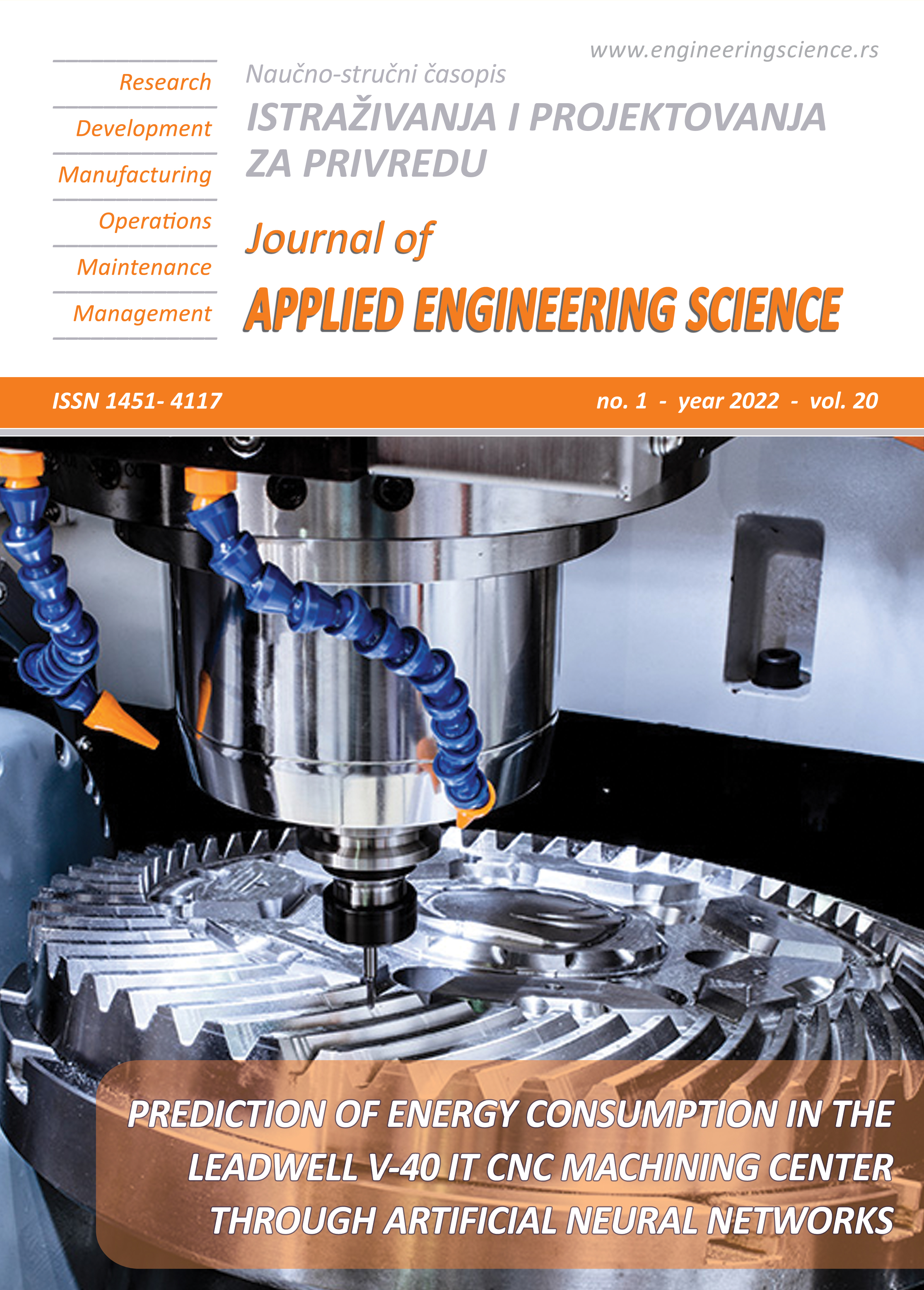EXPERIMENTAL STUDY OF THE MECHANICAL EFFECT OF BIO-LOADS ON PVC RECYCLING
Abstract
With the increase in plastic waste, recycling becomes an urgent necessity to reduce and revalue it. PVC is one of the most widely used types of plastic in the world, and indeed it is among the most recycled.
The effect of recycling on PVC or any other type of material is to reduce these characteristics, which also depends on the method by which it is recycled.
Finding a way to increase the recyclability number of PVC by improving the mechanical characteristics will be an addition at the level of scientific research as well as at the industrial level.
The addition of a bio-loading in the form of cow horns, coconut or chicken feathers on the rigid and flexible PVC with an experimental study of the results obtained allow to deduce the most adequate bio-loaded material to improve the mechanical characteristics after recycling.
The experiments carried out on rigid and flexible PVC demonstrated the evolutions brought to PVC with and without loading after recycling
The results obtained showed an improvement in the mechanical properties of rigid and flexible PVC with a natural bio-loading with the three fibers of coconut, cow horns and chicken feathers which enhance the environment, are very light and can be collected. directly from the waste with a large amount.
References
Lakhdar, A., Moumen, A., Zahiri, L., Jammoukh, M., Mansouri, K. (2020). Experimental and Numerical Study of the Mechanical Behavior of Bio-Loaded PVC Subjected to Aging. Adv. Sci. Technol. Eng. Syst. J. 5(5), 607-612, DOI: 10.25046/aj050574
Moumen, A.,Jammoukh, M., Zahiri, L., Mansouri, K. (2020).Study Of The Optimal Micromechanical Behavior Of A Polymer Reinforced By Snail Shell Particles Using The Mori-Tanaka Numerical Model. IEEE International conference of Moroccan Geomatics (Morgeo), 1–6, 2020, doi:10.1109/Morgeo49228.2020.9121908
Janajreh, I., Alshrah, M., Zamzam, S. (2015). Mechanical recycling of PVC plasticwaste streams from cable industry: A case study. Sustainable Cities and Society, 18, 13–20.
DJEBBAR, S., YOUSSFI, B. (2014) .contribution to the enhancement of poultry feathers as an element of fungal fermentation. microbiology department, constantine university, 53.
Lakhdar, A., Zahiri, L., Jammoukh, M., Moumen, A., Mansouri, K., Salhi, B. (2020).Numerical and Experimental Study of the Behavior of PVC Material Subjected to Aging. 1st International Conference on Innovative Research in Applied Science, Engineering and Technology (IRASET), IEEE: 1–6.
Coconut, UNITED NATIONS CONFERENCE ON TRADE AND DEVELOPMENT, INFOCOMM, New York and Geneva, 2016 p12
Hanafi, M. (2017). Mechanical Properties of Coconut Shell Powder Reinforced PVC Composites in Automotive Applications. Journal of Mechanical Engineering. 14. 49-61.
Moumen, A., Jammoukh, M., Zahiri, L., Mansouri, K. (2020).Numerical modeling of the thermo mechanical behavior of a polymer reinforced by horn fibers. International Journal of Advanced Trends in Computer Science and Engineering,9(4), 6541–6548, doi:10.30534/ijatcse/2020/342942020
Nemat, S., Hori, M. (1993). Micromechanics: overall properties of heterogeneous materials.
V Titow, W. (1984). Stabilisers: general aspects. Springer: 255–333.
Jammoukh, M., Mansouri, K., Salhi, B. (2018).Industrial and ecological effect of a bio-load on polymers. 10p .
Fonds de la CNUCED pour l'information sur les marchés des produits de base agricoles. (2016). Noix de coco, Un profil de produit de base par INFOCOMM.CONFERENCE DES NATIONS UNIES SUR LE COMMERCE ET LE DEVELOPPEMENT, p12, New York et Genève.
Coralie, B., Audrey, S. (2011). Aspects botaniques, applications et perspectives thérapeutiques de cocos nucifera L. Université de Nantes.
Raghavendra, S.N., Ramachandra, S.R., Swamy., Rastogi, N.K., Raghavarao, K.S.M.S., Kumar, S., Tharanathan, R.N. (2006) Grinding characteristics and hydration properties of coconut residue: A source of dietary fiber.Journal of Food Engineering,Volume 72, Issue 3,Pages 281-286,https://doi.org/10.1016/j.jfoodeng.2004.12.008>
Lomelí-Ramírez, M., Kestur, S., Manríquez-González, R., Iwakiri, S., Bolzon de Muniz,., Flores-Sahagun, T.(2014). Bio-composites of cassava starch-green coconut fiber: Part II—Structure and properties.Carbohydrate Polymers,Volume102,576583,https://doi.org/10.1016/j.carbpol.2013.11.020.>
Aranberri , I., Montes ID , S., Azcune, I., Rekondo, A., Grande, H. (2017) .Fully Biodegradable Biocomposites with High Chicken Feather Content. CIDETEC Research Centre, Paseo de Miramón, 196, 20014 Donostia-San Sebastián (Gipuzkoa), Spain, Polymers, 9, 593
Ansarullah.,Rahim, R., Kusno, A., Baharuddin.,Jamala, N. (2018). Utilization of waste of chicken feathers and waste of cardboard as the material of acoustic panel maker.IOP Conf. Ser.: Earth Environ. Sci. 126 012036.
Schmidt, W.F. (1998). Innovative Feather Utilization Strategies.in Poultry Waste Management Conference, Springdale,Arkansas.
Mohanty, AK., Misra, M., Drzal, LT.(2002). Sustainable biocomposites from renewableresources: opportunities and challenges in the green materials world. J PolymEnviron,10(1–2):19–26.
Narendra Reddy Æ Yiqi Yang. (2007). Structure and Properties of Chicken Feather Barbs as NaturalProtein Fibers.Springer Science+Business Media, LLC 2007, J Polym Environ 15:81–87, DOI 10.1007/s10924-007-0054-7
Dash, A.,Tripathy, S. (2018) .Mechanical characteristics of chicken feather teak wooddust epoxy filled composite.International Conference on Mechanical, Materials and Renewable Energy, IOP Conf. Series: Materials Science and Engineering 377, 012111, doi:10.1088/1757-899X/377/1/012111.
Fonds de la CNUCED pour l'information sur les marchés des produits de base agricoles. (2016). Noix de coco, Un profil de produit de base par INFOCOMM.CONFERENCE DES NATIONS UNIES SUR LE COMMERCE ET LE DEVELOPPEMENT, p12, New York et Genève.
C.D.E.S. Activités, L. De Vinylplus. (2020). PROGRESS REPORT 2020 REPORTING ON 2019 ACTIVITIES. 2017.40:7-12.
Lakhdar, A., Moumen, A., Mansouri, K. (2021). Study Of The Mechanical Behavior Of Bio Loaded Flexible Pvc By Coconut And Horn Fibers Subjected To Aging.International Journal on Technical and Physical Problems of Engineering (IJTPE), Iss. 46, Vol. 13, No. 1.
Lakhdar, A., Moumen, A., Mansouri, K. (2021). Recycled PVC with chicken feathers as bio-load. IOP Conference Series Materials Science and Engineering, India.
Dahir n° 1-06-153, 30 Chaoual 1427 (2006). Law No. 28-00 on waste management and disposal.Morocco, BO n° 5480.
ECOFIND , Analyse de la maturité. Les fibres naturelles à partir de déchets de coco, from www.recube.frDécouvrezenplussurEcofindici:https://vimeo.com/173891553, accessed on 2021-01-10.
CHENNAOUI, M., FARID, F., HAMDANI, A., MOUNTADAR, M., ASSOBHEI, O. (2012).Biotransformation des déchets d’abattoir en vue de leur valorisation dans l’alimentation animale. DÉCHETS SCIENCES & TECHNIQUES - REVUE FRANCOPHONE D’ÉCOLOGIE INDUSTRIELLE - N° 61

